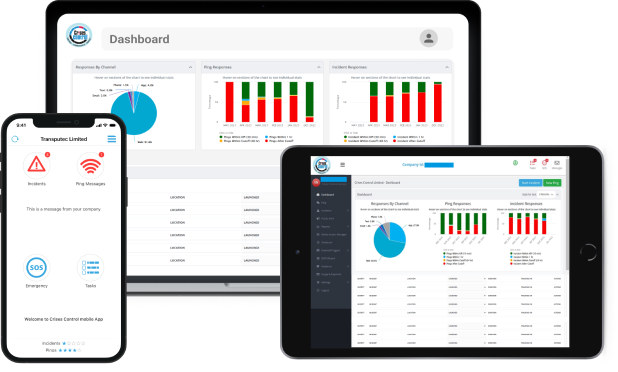Written by Chanay Blomkamp | Crises Control Marketing Assistant
Why Every Second Matters in a Healthcare Crisis
Hospitals never get the luxury of slowing down when problems appear. Whether it is a cyberattack that locks access to patient records, a fire in a critical ward or a sudden influx of emergency cases, delays can lead to serious consequences. Many healthcare providers still rely on outdated communication methods or siloed systems that fail under pressure. When messages do not reach the right people or response teams cannot mobilise quickly, the outcome is operational chaos and patient risk.
That is the problem. The solution is purpose‑built crisis management tools for healthcare providers. With the right technology in place, hospitals and clinics can respond faster, coordinate more effectively and protect lives during high‑pressure situations.
In this blog, we will look at the challenges healthcare teams face during emergencies, how crisis management platforms work and how Crises Control is helping hospitals build stronger, smarter responses.
What Makes Healthcare Crises So Complex
Healthcare organisations operate in high‑stakes environments. Patients, staff and essential services are all vulnerable when things go wrong. Even a brief disruption can have life‑or‑death implications.
Common crisis events in healthcare include:
- Cyberattacks targeting digital patient records or hospital systems
- Fires, floods or power failures affecting key services
- Pandemic‑driven staff shortages
- Mass casualty incidents or unexpected surges in patients
- Infrastructure or supply chain disruptions
These events demand fast, coordinated responses. Without reliable communication and incident management systems, even experienced teams struggle to maintain control. Staff may not know what is happening, who is responsible for what or where to go for support. That is where crisis management tools make the difference.
Crisis Management Tools for Healthcare Providers: How They Help
Modern crisis management platforms do more than send alerts. They give hospitals the ability to plan, respond and recover from emergencies quickly and clearly.
A good system should include:
- Clear, multi‑channel alerts that reach staff by text, app, email, call or desktop
- Ready‑made response plans and tasks for common scenarios
- Two‑way messaging so staff can reply, ask questions and confirm receipt
- Dashboards that show who has responded and what actions have been completed
- Location‑based alerts to target the right people in the right areas
- Secure data storage that meets healthcare compliance standards
These features remove guesswork. Everyone receives the right message at the right time with clear steps to follow.
Why Emergency Communication Tools Matter in Healthcare
Effective communication during a crisis is essential. Hospitals rely on hundreds of people working together across departments, shifts and locations. When something unexpected happens, those people need accurate information and clear instructions.
For example:
- A fire breaks out in one part of the hospital. Staff in that area need evacuation instructions. Others need to reroute patients and avoid that wing.
- A cyberattack locks access to records. Teams need to switch to paper processes and IT needs to isolate the threat quickly.
- A virus outbreak affects staffing. Managers need to contact available staff, fill shifts and keep essential services running.
In each situation, speed and clarity decide the outcome. Communication failures can turn small issues into large‑scale problems. Reliable tools give staff confidence and give leaders control.
How Crises Control Helps Healthcare Providers Respond Faster
Crises Control is designed to help healthcare organisations respond to disruption with confidence. It combines emergency communication, incident management and business continuity planning in one platform.
Here is how Crises Control adds value:
- Multi‑channel alerts: Messages go out instantly across SMS, app notifications, voice calls and email, ensuring they reach everyone even if some systems are down.
- Mobile‑first design: Many healthcare professionals are on the move. Crises Control’s mobile app lets users receive alerts, view instructions and respond to tasks wherever they are.
- Incident playbooks: Pre‑set workflows guide teams through every step of the response. Whether it is a lockdown, an IT outage or an evacuation, everyone knows what to do.
- Two‑way messaging: Leaders get instant feedback from staff. Acknowledgements show who has seen the alert and follow‑up questions keep communication flowing.
- Real‑time dashboards: Visual dashboards show how a situation is developing, what actions have been taken and who still needs support.
- Compliance and reporting: All activity is logged securely, helping teams meet legal obligations and support post‑incident reviews.
These tools help hospitals react quickly, reduce confusion and get operations back on track sooner.
Real‑Life Examples of Crisis Management in Healthcare
Crises Control is already used by healthcare providers to manage critical incidents more effectively. Here are a few scenarios that show how it works in practice:
- Cyberattack on Hospital Systems: A hospital lost access to patient records after a ransomware attack. Crises Control alerted all departments, activated offline procedures and notified the IT response team. Backup processes started within minutes and services continued with minimal disruption.
- Fire in a Hospital Wing: A small fire forced the evacuation of a ward. Crises Control sent targeted messages to affected staff and directed others to support patients in neighbouring areas. Leadership received real‑time updates.
- Staffing Challenges During a Pandemic: During a COVID wave, staff shortages hit critical levels. The hospital used Crises Control to alert available personnel, fill priority shifts and coordinate volunteers. Response time improved significantly.
These real‑world uses show how effective communication and planning tools make a difference when time is critical.
Beyond Compliance: Building Long‑Term Resilience
Many hospitals start looking for crisis management solutions to meet regulatory standards. The real benefit is much larger. Good tools help organisations build resilience that endures.
Crises Control does not just help during a crisis. It also supports:
- Faster recovery times
- Fewer disruptions to services
- Clearer roles and responsibilities
- More confident staff
- Better outcomes for patients
It is not simply about ticking a box. It is about making sure your hospital can continue to care for patients, whatever happens.
Conclusion: Take Control Before the Crisis Starts
Disruption in healthcare is not a question of if, but when. Whether it is a sudden systems failure, a staffing shortage or an emergency that puts patient safety at risk, having a robust communication and response plan can make all the difference.
Crises Control helps healthcare organisations stay one step ahead by giving teams the tools they need to respond fast, stay connected and maintain critical services under pressure. It brings structure to chaos, clarity to confusion and confidence to teams at every level.
Contact us for your free demo today to request a free personalised demo and see how Crises Control can support your hospital’s crisis readiness from day one.
Request a FREE Demo

FAQ’s
1. What is the main advantage of using a dedicated crisis management platform instead of email or phone trees?
2. How long does it take to implement Crises Control in a hospital?
3. Can smaller clinics benefit from crisis management tools or are they only for large hospitals?
4. How often should hospitals test their crisis plans?
Best practice recommends tabletop exercises at least twice a year and a full live drill annually. Regular testing familiarises staff with procedures, highlights gaps and ensures plans evolve alongside changes in technology, staff and risks.
